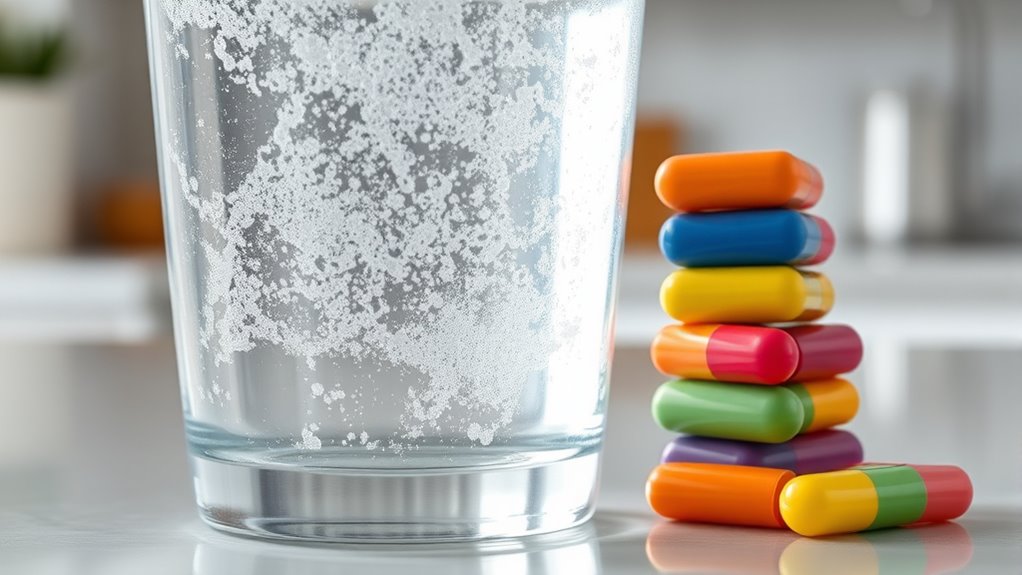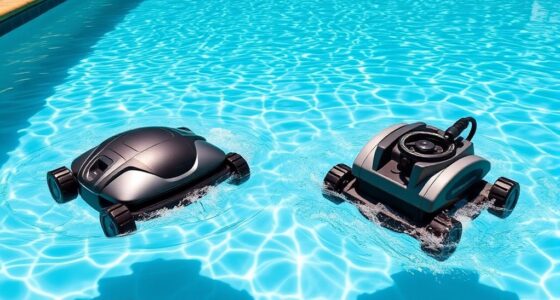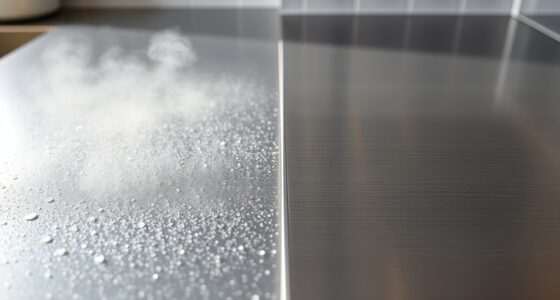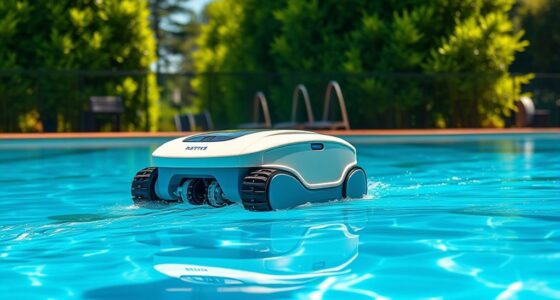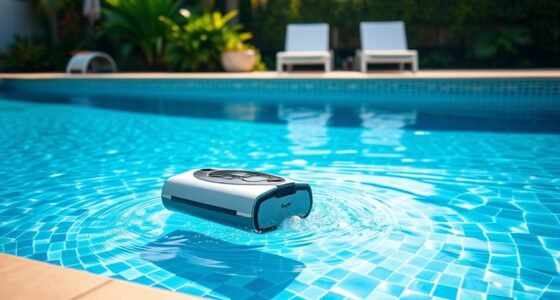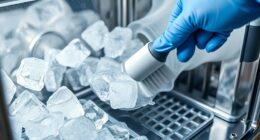To get the right detergent-to-water ratio in hard water, first test your water’s hardness level using a kit or contact your utility. You might need to increase the detergent amount — sometimes doubling or tripling — to overcome mineral interference. Using water softeners can also help boost detergent effectiveness and reduce amount needed. Proper ratio management improves cleaning results and prolongs appliance life. Keep exploring to learn more tips for managing hard water challenges effectively.
Key Takeaways
- Test water hardness with kits to determine the appropriate detergent amount.
- Use more detergent in very hard water, sometimes doubling or tripling the recommended amount.
- Opt for detergents formulated specifically for hard water to improve cleaning efficiency.
- Pre-dissolve detergent before adding to wash or cleaning solutions for even distribution.
- Regularly monitor water hardness to adjust detergent ratios and prevent residue buildup.
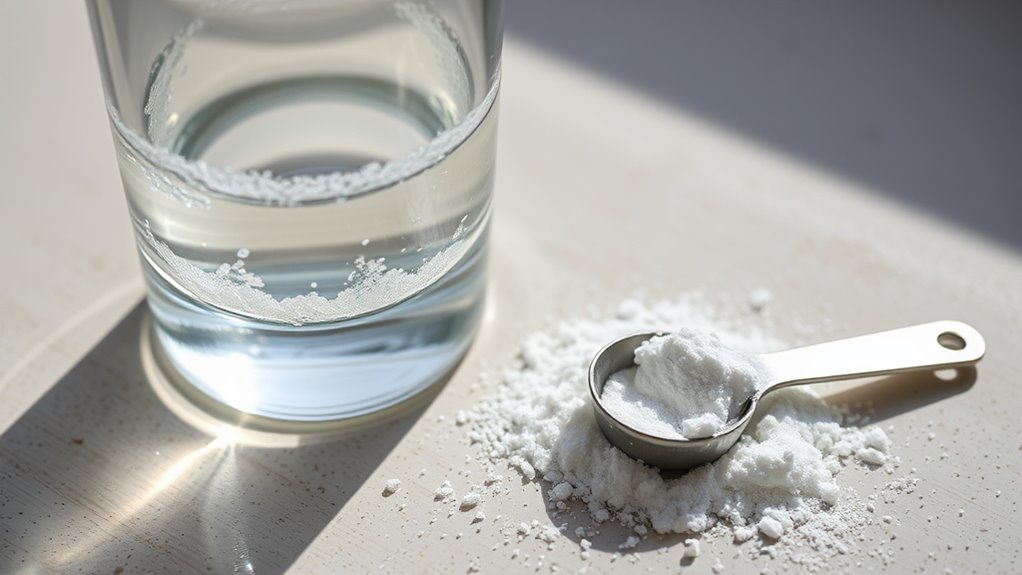
Have you ever noticed that soap doesn’t lather well or that your clothes don’t feel as clean as they should? If so, hard water might be the culprit. Hard water contains high levels of minerals like calcium and magnesium, which can interfere with how detergents work. When these minerals are present in large amounts, they react with soap to form insoluble compounds called scum. This scum not only reduces the soap’s ability to produce lather but also leaves residues on your skin, clothes, and even your appliances. Understanding how to manage the ratio of detergent to water is key to getting the most out of your cleaning routine.
Hard water reacts with soap, forming scum that reduces lather and leaves residues.
The main issue with hard water is that it consumes the soap you add, turning it into insoluble soap scum instead of foam. This means you need more soap or detergent to achieve the same cleaning power. But using more isn’t always the solution because excess detergent can leave behind residues, cause skin irritation, and make your clothes look dull. Instead, you need to find the right balance—adding enough detergent to counteract the minerals without overdoing it. Typically, manufacturers recommend specific amounts for soft water, but in hard water areas, you might need to double or triple that amount. The key is to follow the instructions carefully and adjust based on your water hardness level.
To get the ratios right, it helps to know your water’s hardness. You can get a simple test kit at a hardware store or contact your local water utility. Once you know how hard your water is, you can adjust your detergent use accordingly. For example, if your water is very hard, consider using detergents formulated for hard water or adding a water softener to your laundry routine. Water softeners work by replacing calcium and magnesium ions with sodium or potassium ions, which don’t interfere with soap’s ability to lather. This simple addition can make a big difference, allowing you to use less detergent and achieve cleaner results.
Another practical tip is to pre-dissolve your detergent before adding it to the wash or cleaning solution. This helps ensure the detergent is evenly distributed and can better react with the minerals in hard water. Also, avoid overloading your washing machine or sink, as this can reduce water circulation and make it harder for detergents to do their job effectively. Additionally, understanding the water hardness level can help you select the most appropriate cleaning strategies. Ultimately, understanding the right ratio of detergent to water, considering your water’s mineral content, will improve your cleaning results and prolong the life of your appliances and clothing. It’s all about striking the perfect balance to combat the effects of hard water.
Frequently Asked Questions
Can I Use the Same Detergent for Both Hard and Soft Water?
You shouldn’t use the same detergent for both hard and soft water. Hard water requires specialized detergents with water softening agents to prevent mineral buildup, while soft water works well with regular detergents. Using the wrong type can reduce cleaning efficiency and cause soap scumming or deposits. Check labels carefully and choose detergents formulated for your water type to guarantee best cleaning and prevent damage to fabrics and appliances.
How Does Water Hardness Affect Laundry Detergent Effectiveness?
Water hardness reduces laundry detergent effectiveness because the minerals in hard water react with soap and some detergents, forming insoluble scum. This prevents detergents from cleaning fabrics thoroughly. To improve results, you can use water softeners or specialized detergents designed for hard water. Adjust your laundry routine by increasing detergent amounts slightly or choosing formulations that work well in mineral-rich water, ensuring your clothes come out clean and fresh.
Are There Specific Detergents Formulated for Hard Water?
You bet there are detergents designed specifically for hard water. Think of them as your secret weapon, tackling mineral buildup head-on. These formulations contain chelating agents and water softeners that bind to minerals, preventing soap scumps. It’s like putting a shield between your detergent and the minerals in water, ensuring your laundry comes out fresh and clean. When in doubt, choose a detergent labeled for hard water—it’s a smart move.
What Are the Long-Term Effects of Hard Water on Appliances?
Hard water can cause mineral buildup inside your appliances, leading to decreased efficiency and potential damage over time. You might notice your dishwasher or washing machine working harder or showing signs of wear. The minerals can clog pipes and reduce the lifespan of appliances, resulting in costly repairs or replacements. To protect your appliances, consider installing water softeners and performing regular maintenance to minimize mineral deposits.
How Can I Test My Water Hardness at Home?
You can test your water hardness at home using a water testing kit available at most hardware or online stores. Simply fill the test vial with water, add the included reagent, and compare the color change to the provided chart. This quick and affordable method lets you determine if your water is soft or hard, helping you decide on necessary water treatment measures. Always follow the instructions for accurate results.
Conclusion
Remember, you’re only as good as your ratios. When you mix hard water with detergents, getting the balance right makes all the difference. Use too much detergent, and you’ll waste soap and still struggle with stains; too little, and dirt just won’t come off. Keep experimenting until you find that sweet spot. As the saying goes, “A stitch in time saves nine”—taking the time to get your ratios right now saves you effort later.
